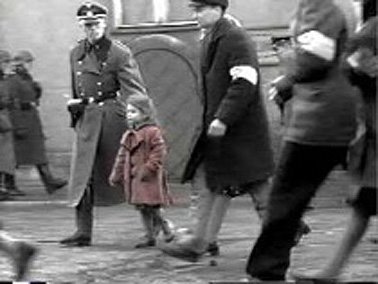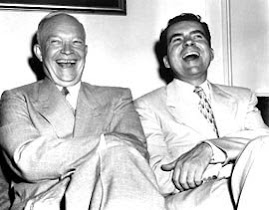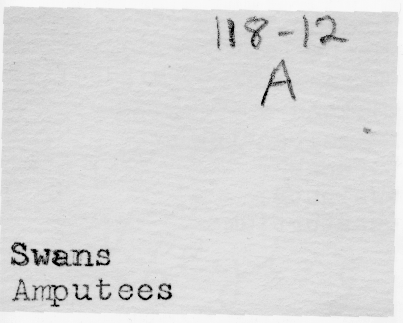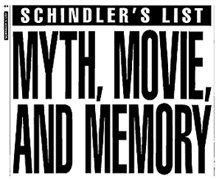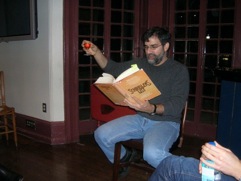 Years ago I wrote a review-essay on a book about the Cold War-era prosecutions of leaders of the Communist Party of the U.S. - the so-called Foley Square Trials which began in 1949 (Dennis v. U.S.). What interested me was the theory of language implicit in the way the prosecution presented--or felt they had to present--their case. They went after these American communists for acts they didn't do but said they would do; but they didn't even have evidence for such saying, so they proved that illegal acts would occur in the future based on what the communists read and said about what they read.
Years ago I wrote a review-essay on a book about the Cold War-era prosecutions of leaders of the Communist Party of the U.S. - the so-called Foley Square Trials which began in 1949 (Dennis v. U.S.). What interested me was the theory of language implicit in the way the prosecution presented--or felt they had to present--their case. They went after these American communists for acts they didn't do but said they would do; but they didn't even have evidence for such saying, so they proved that illegal acts would occur in the future based on what the communists read and said about what they read. Here are two paragraphs from the beginning of the review and part of a third paragraph from a little later on - and here is the whole review (published in the summer 1987 issue of American Quarterly):
Peter Steinberg's The Great "Red Menace" tells the story of the 1949 Smith Act trial of leaders of the Communist Party of the United States (CPUSA), which culminated in the 1951 Dennis v. United States decision. In that decision the Supreme Court upheld Judge Harold Medina's ruling that the First Amendment certainly does not extend to those who conspire to advocate the violent overthrow of the American government. The exposition is brilliant: Steinberg alternates between groups of chapters written from the perspective of the government and its prosecutors on the one hand, and the beleaguered CPUSA on the other. Telling the story of the prosecution of a small and by-then uninfluential political group may not seem to require the time and space it has taken, but if we focus on a shift in the conception of American language marked by the trial and the Dennis decision, we will find plenty to go on.
 The shift will seem as dramatic to "new" American literary historians as to a new, skeptical generation of legal theorists, and that is perhaps why, with the two disciplines now sharing much the same ground, Steinberg's good work is so timely. In the 1919 Schenck decision, the Supreme Court ruled that to decide if subversive language was not protected by the right to free speech the courts would have to test the direct relation between the writing and the prohibit able action. One could not shout fire in a theater if there were no fire, Justice Holmes wrote in the famous metaphor; if one did falsely shout, the falsity would be clear enough (where was the fire?), and the connection of the language shouted to the ensuing harm was present (for example, theatergoers trampling one another to get out). A court could expect the prosecution to demonstrate both clarity and presence. The high court thus used an abstract notion of proximity--that is, of language to action; of language intended to lead to action to the action itself--but tried to look away from the intention in the language and as exclusively as possible at the action, and in this way demanded the relevance of external evidence to the interpretation of language. Investigators and attorneys working on behalf of the American government in 1951 had no choice but to reshape the doctrine of clear and present danger if they wanted to define American communist language as suggesting illegality; and, as Steinberg demonstrates, they wanted this very badly.
The shift will seem as dramatic to "new" American literary historians as to a new, skeptical generation of legal theorists, and that is perhaps why, with the two disciplines now sharing much the same ground, Steinberg's good work is so timely. In the 1919 Schenck decision, the Supreme Court ruled that to decide if subversive language was not protected by the right to free speech the courts would have to test the direct relation between the writing and the prohibit able action. One could not shout fire in a theater if there were no fire, Justice Holmes wrote in the famous metaphor; if one did falsely shout, the falsity would be clear enough (where was the fire?), and the connection of the language shouted to the ensuing harm was present (for example, theatergoers trampling one another to get out). A court could expect the prosecution to demonstrate both clarity and presence. The high court thus used an abstract notion of proximity--that is, of language to action; of language intended to lead to action to the action itself--but tried to look away from the intention in the language and as exclusively as possible at the action, and in this way demanded the relevance of external evidence to the interpretation of language. Investigators and attorneys working on behalf of the American government in 1951 had no choice but to reshape the doctrine of clear and present danger if they wanted to define American communist language as suggesting illegality; and, as Steinberg demonstrates, they wanted this very badly. ...When Harold Medina instructed the jury that "words may be the instruments by which crimes are committed" as Steinberg quotes him (Steinberg has performed the heroic task of reading the entire million-plus-word transcript of the trial), the judge was making sure the jury understood that it was their duty to interpret intention. He was "instructing" them to read the texts of subversion thus: punishable advocacy was that which would incite illegal action "by language reasonably and ordinarily calculated to do so." At this rate--and in a moment I will turn to the Congressional hearings of writers to show this specifically--Holmes' falsely shouted "Fire!" in the theater may as well have been uttered by a player in the play for all the attention actually paid to text in context. In order to shift attention away from the expectation that some evidence, any evidence, would be brought into the court establishing that any one of the twelve communist defendants had themselves acted illegally at a certain time, or had proposed to act illegally, or had taught others the specific duty to act illegally--no such evidence was ever introduced--the prosecution began with the witness Louis Budenz whose testimony is undoubtedly the oddest ever admitted in an American criminal trial. The strategy was to ask the judge to allow as evidence readings from "classic texts," works by or about communists, which would establish what all communists do by suggesting what one of them once intended. Anticipating that the defense, conducted by Eugene Dennis himself, would offer counter examples of classic texts arguing for change through peaceful means, Budenz then stunned the defendants by introducing the notion of "the Aesopian language thesis." According to the Aesopian language thesis, communist language was hardly ever meant literally. CPUSA communicated in codes of metaphors, synecdoches, and antitheses. If Dennis produced a text which claimed "peace" as the communists' objective, it was to be read as intending "war." The trick was to catch the communist-influenced writer off his guard, saying what he really meant.
...When Harold Medina instructed the jury that "words may be the instruments by which crimes are committed" as Steinberg quotes him (Steinberg has performed the heroic task of reading the entire million-plus-word transcript of the trial), the judge was making sure the jury understood that it was their duty to interpret intention. He was "instructing" them to read the texts of subversion thus: punishable advocacy was that which would incite illegal action "by language reasonably and ordinarily calculated to do so." At this rate--and in a moment I will turn to the Congressional hearings of writers to show this specifically--Holmes' falsely shouted "Fire!" in the theater may as well have been uttered by a player in the play for all the attention actually paid to text in context. In order to shift attention away from the expectation that some evidence, any evidence, would be brought into the court establishing that any one of the twelve communist defendants had themselves acted illegally at a certain time, or had proposed to act illegally, or had taught others the specific duty to act illegally--no such evidence was ever introduced--the prosecution began with the witness Louis Budenz whose testimony is undoubtedly the oddest ever admitted in an American criminal trial. The strategy was to ask the judge to allow as evidence readings from "classic texts," works by or about communists, which would establish what all communists do by suggesting what one of them once intended. Anticipating that the defense, conducted by Eugene Dennis himself, would offer counter examples of classic texts arguing for change through peaceful means, Budenz then stunned the defendants by introducing the notion of "the Aesopian language thesis." According to the Aesopian language thesis, communist language was hardly ever meant literally. CPUSA communicated in codes of metaphors, synecdoches, and antitheses. If Dennis produced a text which claimed "peace" as the communists' objective, it was to be read as intending "war." The trick was to catch the communist-influenced writer off his guard, saying what he really meant.






 "I teach horizontally, meaning that while I might begin with a fixed idea of what I'm going to teach that day, I let it drift rhizomatically way off topic, often pulling it back when it gets too far. I rely on non-fixed materials to teach this way; the whole world is at my fingertips. Should I go off on a tangent about John and Rauschenberg and their love relationship as expressed in Rauschenberg's bed, an image of that bed is always a click away. From there, we can head anywhere into the non-fixed universe, be it film, text or sound. And of course, that always takes us elsewhere. As Cage says, 'We are getting nowhere fast.'"
"I teach horizontally, meaning that while I might begin with a fixed idea of what I'm going to teach that day, I let it drift rhizomatically way off topic, often pulling it back when it gets too far. I rely on non-fixed materials to teach this way; the whole world is at my fingertips. Should I go off on a tangent about John and Rauschenberg and their love relationship as expressed in Rauschenberg's bed, an image of that bed is always a click away. From there, we can head anywhere into the non-fixed universe, be it film, text or sound. And of course, that always takes us elsewhere. As Cage says, 'We are getting nowhere fast.'" 

 that anyone has yet got the imaginative measure of that terrifying day six years ago. Certainly our Tolstoy has not crawled out of the rubble. The closest we have, Don DeLillo, succeeded as an essayist-journalist ("In the Ruins of the Future: Reflections on Terror and Loss in the Shadow of September,” Harper’s, December 2001) but, to my mind, failed as a novelist ("Falling Man"). One reason, perhaps, is that the remembered emotion was instantly buried under a pile of cultural junk.' - Tod Gitlin in his review of Susan Faludi's The Terror Dream (written for
that anyone has yet got the imaginative measure of that terrifying day six years ago. Certainly our Tolstoy has not crawled out of the rubble. The closest we have, Don DeLillo, succeeded as an essayist-journalist ("In the Ruins of the Future: Reflections on Terror and Loss in the Shadow of September,” Harper’s, December 2001) but, to my mind, failed as a novelist ("Falling Man"). One reason, perhaps, is that the remembered emotion was instantly buried under a pile of cultural junk.' - Tod Gitlin in his review of Susan Faludi's The Terror Dream (written for 


